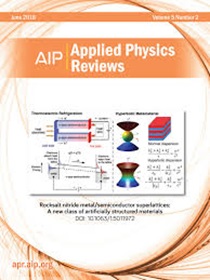Integrated strategy for icing/fogging mitigation with electromagnetic metamaterials and thin film surface acoustic waves
IF 11.9
1区 物理与天体物理
Q1 PHYSICS, APPLIED
引用次数: 0
Abstract
Icing, fogging, and frosting cause safety hazards, reduced energy efficiency, and operation difficulties in various sectors including aerospace and renewable energy. Traditional methods for mitigating these hazards are often based on active transducers that are either inconvenient, energy intensive, or utilizing chemicals that are detrimental to the environment and lacking long-term stability. To tackle the challenges of in situ monitoring and mitigating fogging and icing hazards on structural surfaces, we explored an integrated platform by combining electromagnetic (EM) metamaterials and piezoelectric thin film-based surface acoustic wave (SAW) technologies. Icing monitoring was performed using EM metamaterial based on SAW electrodes with advantages of wireless and non-contact detection, and effective de-icing functions were achieved through harnessing mechanical vibrations, acousto-thermal, and acoustic streaming effects generated by the SAWs. This integrated platform is modular and scalable up for practical applications requiring fogging/icing detection and prevention systems. Our results have shown that the resonant frequency of the metamaterial device was decreased with accumulation of condensation on the surface of the device, which showed the fulfillment of sensing and monitoring. Results also showed that as the applied SAW power was increased, the time taken for de-fogging and de-icing were significantly decreased.利用电磁超材料和薄膜表面声波缓解结冰/雾化的综合战略
本文章由计算机程序翻译,如有差异,请以英文原文为准。
求助全文
约1分钟内获得全文
求助全文
来源期刊

Applied physics reviews
PHYSICS, APPLIED-
CiteScore
22.50
自引率
2.00%
发文量
113
审稿时长
2 months
期刊介绍:
Applied Physics Reviews (APR) is a journal featuring articles on critical topics in experimental or theoretical research in applied physics and applications of physics to other scientific and engineering branches. The publication includes two main types of articles:
Original Research: These articles report on high-quality, novel research studies that are of significant interest to the applied physics community.
Reviews: Review articles in APR can either be authoritative and comprehensive assessments of established areas of applied physics or short, timely reviews of recent advances in established fields or emerging areas of applied physics.
 求助内容:
求助内容: 应助结果提醒方式:
应助结果提醒方式:


